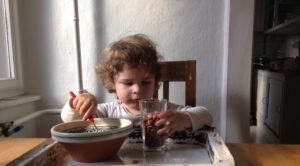We recognize objects even when we just see a part such as a bicycle that is partly hidden by a wall with only the wheel being visible. The brain says “cup” when all we see is the handle, or face when we see mouth. Recognition of the whole is based on a comparison between what we see and a model of the full image in our memory. If we show progressively less of the object to be recognized or we diminish its resolution there comes a point where recognition is impossible. There is a minimum amount of info that an image must give us for the object it refers to, to be recognizable and this amount is the same for almost everybody. The less info supplied the more we must concentrate to guess what it refers to. Vice versa the more info the less we have to concentrate on every detail. Paying attention is tiring and has a cost and so calibrating the right quantity of energy to spend in each circumstance is important. This means that there will be times when it pays to not pay attention if this means saving precious energy for when it is indispensable to pay attention. This energy saving is usually an automatic process. For example, if we see a dog, we don’t waste resources trying to understand that it is a dog. If, however our interest has been stimulated by the fact that this might be a dog that we know went lost then our level of attention increases. The human brain tends towards not paying attention unless its interest has been awoken by some circumstance. Parents and teachers often say to children and students “You are not paying attention!” or “Be more careful!”, but this is often an admission that what is happening is not sufficiently interesting to invert a process of energy conservation.


Leave a Reply